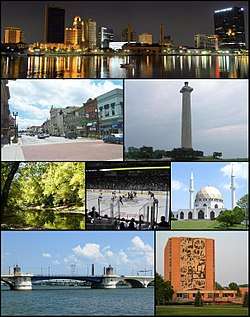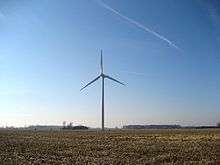Toledo metropolitan area
The Toledo, Ohio, metropolitan area is a metropolitan area centered on the American city of Toledo, Ohio. As of the 2010 census, the metropolitan statistical area (MSA) had a population of 651,429. It is the sixth-largest metropolitan area in the state of Ohio, behind Cincinnati–Northern Kentucky, Cleveland, Columbus, Dayton, and Akron.
Metro Toledo Toledo MSA Toledo–Fremont CSA | |
|---|---|
 Images, from top left to right: Toledo Skyline, Downtown Bowling Green in 2003, Put-in-Bay, Goll Woods Nature Preserve in Fulton County, Toledo Walleye game, Islamic Center of Greater Toledo in Perrysburg Township, MLK Bridge in Toledo, and the Jerome Library in Bowling Green. | |
| Country | |
| State | |
| Largest city | Toledo |
| Other cities | |
| Counties | |
| Area | |
| • Urban | 240.4 sq mi (623 km2) |
| • MSA | 1,619 sq mi (4,190 km2) |
| • CSA | 2,036.7 sq mi (5,275 km2) |
| Population (2010) | |
| • Urban | 507,643 (80th) |
| • Urban density | 2,111.3/sq mi (815.2/km2) |
| • MSA | 651,429 (81st) |
| • MSA density | 402.3/sq mi (155.3/km2) |
| • CSA | 712,373 (66th) |
| Time zone | UTC−5 (EST) |
| • Summer (DST) | UTC−4 (EDT) |
| Area code(s) | 419, 567 |
Located on the border with Michigan, the metropolitan area includes the counties of Fulton, Lucas, and Wood. The Toledo metro area has strong ties to Metro Detroit, located 40 miles (64 km) north. Toledo is also part of the Great Lakes Megalopolis.
The separate micropolitan area of Port Clinton, Ohio, is included in the Toledo–Port Clinton combined statistical area, which includes Ottawa County. The wider region of Northwest Ohio adds Defiance, Hancock, Henry, Paulding, Putnam, Sandusky, Seneca, Van Wert, and Williams counties.
Regional education
There are several institutions of higher education that operate campuses in the area. Some of the larger schools include The University of Toledo, Mercy College of Ohio, and Davis College in Toledo. Lourdes University in Sylvania, Stautzenberger College in Maumee, Owens Community College in Perrysburg Township, and Bowling Green State University in Bowling Green.
Regional economy

According to a 2015 article, there were three Toledo companies that made the Fortune 500 list. #399 is Owens-Illinois (O-I), which specializes in glass and glass packaging. #410 was Dana Corporation which is a global leader in the supply of thermal-management technologies among many other specialties. Lastly, at #498, Owens Corning is the world leading provider of glass fiber technology.[1] Just outside of the Toledo metropolitan in neighboring Findlay, Ohio, #25 Marathon Petroleum Corporation is headquartered.
The economy of Toledo has been heavily influenced by both the economy of nearby Detroit and agriculture. Recently, health care and technology firms have tried to make their way into the metropolitan, though growth in those sectors has been slow. Instead, Toledo and its suburbs are still home to several manufacturing and construction businesses and factories. The Bureau of Labor Statistics reported, in 2015, that manufacturing employment in Toledo had grown by 4.1% between December 2013 and December 2014 (this was double the rate than the United States average). More so, construction job growth grew by nearly 10% in the same time period. In 2014, manufacturing added 1,700 jobs to the Toledo area, but it also saw losses in the business services. In 2014, the US Census Estimated there were roughly 285,000 people employed in the Toledo metropolitan area.[2] In August 2015, it was reported that Toledo's unemployment rate reached a 10-year low, and in June 2015 just 5% of the regional population was unemployed, whereas the United States average unemployment was at 5.3% during the same period.[3]
Demographics
| Historical population | |||
|---|---|---|---|
| Census | Pop. | %± | |
| 1900 | 153,559 | — | |
| 1910 | 192,728 | 25.5% | |
| 1920 | 275,721 | 43.1% | |
| 1930 | 347,709 | 26.1% | |
| 1940 | 344,333 | −1.0% | |
| 1950 | 395,551 | 14.9% | |
| 1960 | 594,151 | 50.2% | |
| 1970 | 644,262 | 8.4% | |
| 1980 | 656,940 | 2.0% | |
| 1990 | 654,157 | −0.4% | |
| 2000 | 659,188 | 0.8% | |
| 2010 | 651,429 | −1.2% | |
| Est. 2018 | 643,640 | [4] | −1.2% |
| U.S. Decennial Census[5] | |||
As of the census[6] of 2010, there were 659,188 people, 259,973 households, and 169,384 families residing within the MSA. The racial makeup of the MSA was 83.03% White, 12.01% African American, 0.25% Native American, 1.07% Asian, 0.02% Pacific Islander, 1.79% from other races, and 1.83% from two or more races. Hispanic or Latino of any race were 4.35% of the population.
The median income for a household in the MSA was $42,686, and the median income for a family was $51,882. Males had a median income of $38,959 versus $25,738 for females. The per capita income for the MSA was $20,694.
Toledo–Port Clinton combined statistical area
The Toledo–Port Clinton combined statistical area includes the Port Clinton micropolitan area. The population of the CSA in 2010 was 651,429.Since the 2000 Census, the Toledo-Fremont CSA has seen a decline in population of 14,468.
All communities and townships
Fulton County
Townships
Lucas County
Communities
Townships
Ottawa County
Communities
Wood County
Communities
Townships
References
- "Fortune 500 & 1000 Companies". Toledo Region.
- "U.S. Census Bureau QuickFacts: Ottawa County, Ohio; Fulton County, Ohio; Wood County, Ohio; Sandusky County, Ohio; Lucas County, Ohio". www.census.gov.
- Elvery, Joel; Vecchio, Christopher (August 27, 2015). "Toledo — Economy Growing, but Slowly". Metro Mix (Toledo, August 2015) – via www.clevelandfed.org.
- "US Census QuickFacts". Retrieved March 25, 2017.
- United States Census Bureau. "Census of Population and Housing". Retrieved June 7, 2016.
- "U.S. Census website". United States Census Bureau. Retrieved 2008-01-31.
.svg.png)
